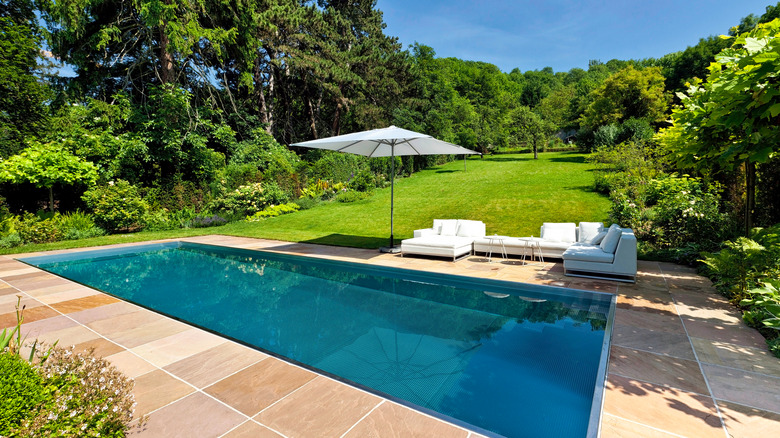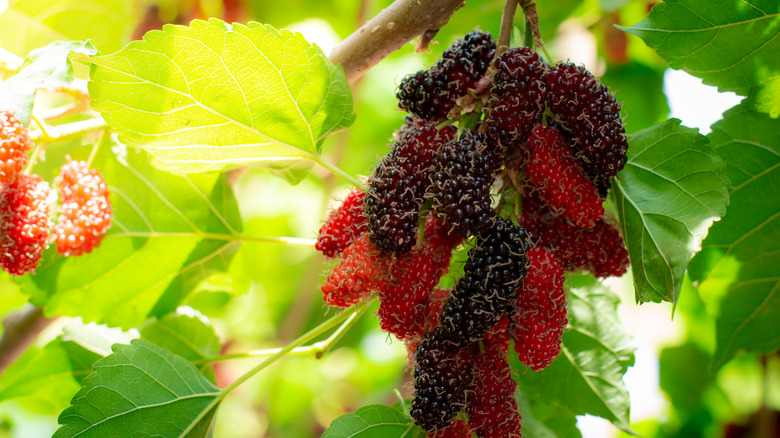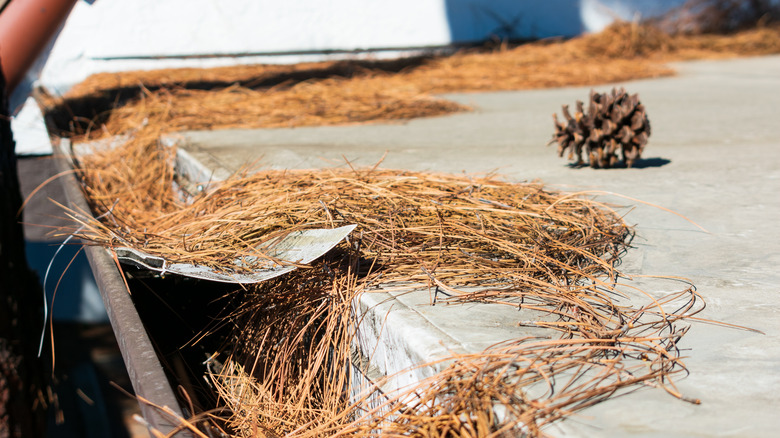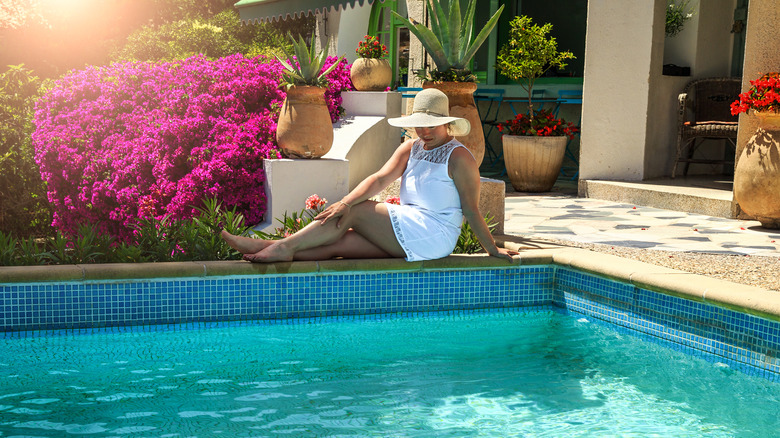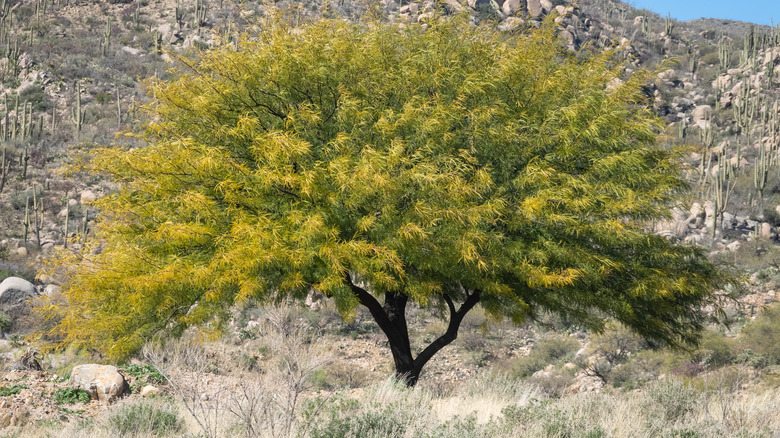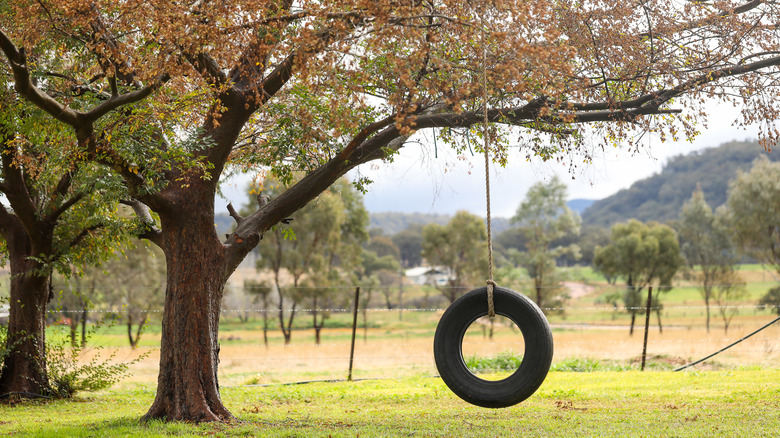5 Messy Plants You Won't Want To Keep Poolside
If you are lucky enough to have a pool in your garden then you know that it's only chemicals, technology, and regular maintenance that keep it from becoming a pond. According to Lowe's, pool hygiene is a delicate balance of chemistry, and responsible pool owners ought to check pH and chlorine levels regularly in order to stay on top of that balance.
Another key consideration for the backyard pool owner is shade. Especially in the hottest months, having easy access to shade in the vicinity of the pool can help you maximize the benefit you get from having a pool. Plants and trees can be a fantastic way to add shade to the space around your pool. However, there are some plants that can create a lot of work, damage your pool equipment, or otherwise cause havoc, according to Backyard Boss.
Per Burke's Backyard, the type of plants best used around a swimming pool are large-leafed shrubs, palm trees, and other plants that are easy to clean up after and don't shed material often. It's also important to remember that tree roots can also damage swimming pools and decking if they are planted in inappropriate spots, according to California Pools. Here are some of the messy plants that would be a disaster if planted next to your pool.
Mulberry
Mulberry trees are beautiful, wide-boughed, and each year weighed down with delicious fruits. Many people have fond childhood memories of growing up near mulberry trees and picking those berries, staining their fingers and faces with the juice. So it's understandable that people want to plant them in their backyards. However, you should not plant them near your pool. According to Albert Group Pools & Patios, the first reason to avoid mulberries is their thick, spreading root system that can cause structural damage to pipes, patios, or even the lining of your pool.
The second reason to avoid poolside mulberry trees is the mess. Wild Abundance explains that ripe mulberries simply drop from the tree, and can be harvested with a light shake of the branches into a waiting sheet below. However, if you have a pool below those fruit-laden boughs, a stiff breeze could turn your pristine swimming pool into an uninviting shade of purple. Not only do dropping mulberries create a mess, but the sticky decomposing fruit could also attract unwanted insects. Mulberry trees can be a fantastic addition to your outdoor space — just make sure you give them the space they need.
Pine Trees
If you are trying to avoid having to scoop fallen leaves from your pool, you might think it makes sense to only plant evergreen trees. No autumn leaf drop and no need to keep scooping leaves out of the pool, right? But according to Utah State University Forestry Extension, pine needles do not stay on the tree forever — a pine tree can drop up to one-third of its needles each year.
What's worse is that pine sap is naturally acidic, which lowers the pool's pH levels, explains Prime Pool Care. On top of this, the fine, needle-like leaves of pine trees are an even worse hazard for pool filtration systems than regular leaves. Some of the pointy needles can make it through narrow gaps that other leaves would be caught by, and a glut of needles can mat together and hold onto other debris to fully clog systems.
Bougainvillea
Bougainvilleas are blooming vines that are native to South America, according to NC State Extension. They are often grown on trellises or fences and give beautiful pops of color and a tropical aspect to the gardens where they grow. Their flowers are actually small, tubular, and white, but they are also almost always accompanied by three to six neon-hued bracts. Bracts aren't petals or flowers themselves, but protective, vibrantly colored leaves.
According to Pool Troopers, Bougainvillea vines can also have thorns about an inch long, so are bad for areas where people will be walking. But what makes bougainvillea plants truly terrible for poolside planting is the bracts. They fall off of the plant en masse in the wind and are so vibrantly colored and papery that they are almost like confetti. Much like pine needles and mulberries, bougainvillea bracts fall a lot at a time and can easily clog filtration systems.
Mesquite
Mesquite is an icon of the American Desert. If you live in an area where they are commonly found, it can be an appealing idea to add garden plants that thrive locally. According to Titan Tree Care, Mesquite is actually a shrub, and in shallow soil, a fully grown mesquite bush might only get to 3 feet tall — however, with deep soil and sufficient irrigation, you could have a tree of 30 to 40 feet high on your hands.
Mesquite trees are tough, they thrive in areas in which other plants would wither and die. They're also prolific and highly competitive. According to Dengarden, most mesquite in the U.S. grows in Texas, where they cover an area of 56 million acres! However, the major issue with Mesquite is that the bushes are covered in lethal thorns, frequently over 3 inches in length. They also grow 10-inch long seedpods, which are covered in a seed coating that's up to 30% sugar, definitely something you don't want in the pool.
Evergreen elm
Evergreen elm, also known as lacebark elm, or Chinese elm, is an excellent shade tree that is native to China, Japan, and Korea. It now thrives in many U.S. states where it is among the most popular trees in urban settings, according to the University of Redlands. While it is aesthetically pleasing, with a thin trunk, a wide crown, and a tolerance for a wide variety of environments, it is a doubly poor poolside tree for some reasons that are familiar, and one that is quite unique.
The Evergreen elm tree releases immense amounts of pollen during late summer and early autumn, and having trees like this in your landscape can be very distressing for anyone with a pollen allergy, per Lawn Love. If it's by your pool, you probably won't be able to swim on some of the hottest days of the summer, warns Allama. On top of the unwelcome pollen dump, Chinese elm is also known to be a messy tree, according to the USDA, dropping lots of fruit at the same time, which we know is terrible for pools, and causing more and more seedlings to grow.
